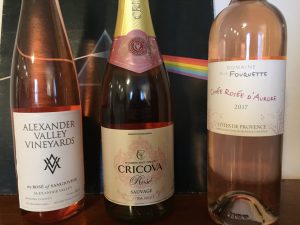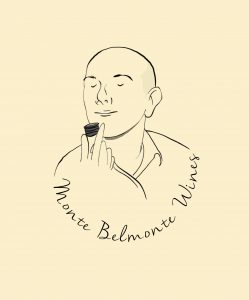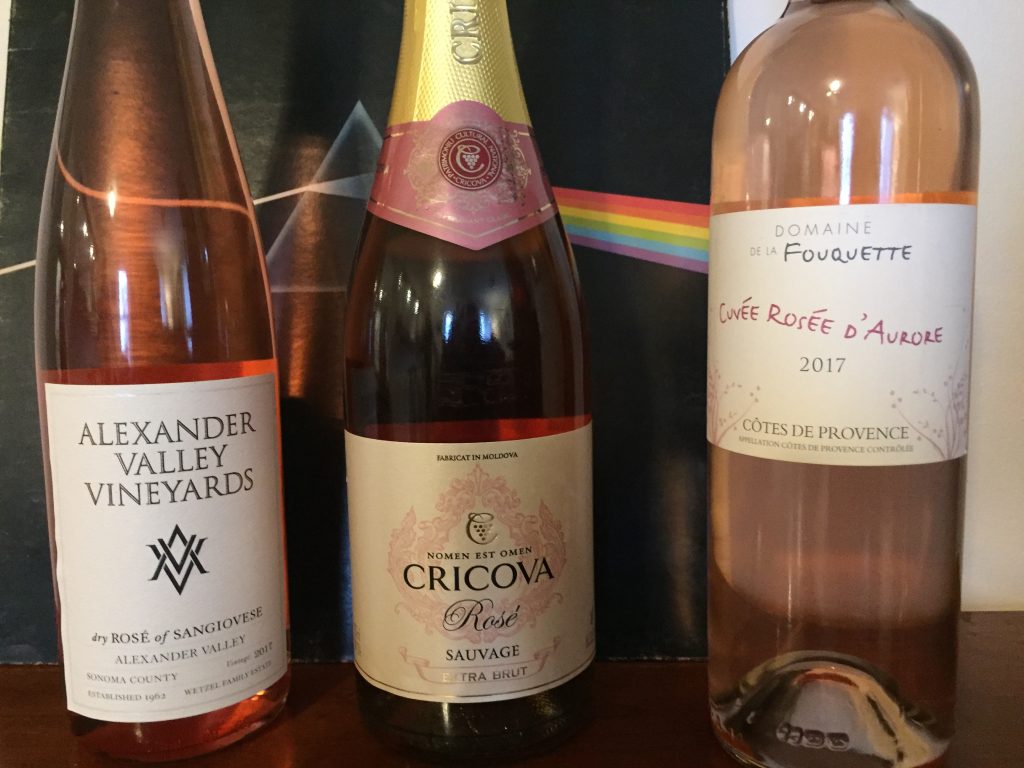White Zinfandel ruined rosé. My Italian grandmother, Nana B, always had a bottle of Sutter Home White Zinfandel open in her fridge. She called it “Zin-fan-DEL,” with the accent on the last syllable. I was allowed small sips as a child, and my mental memory of those sips helps inform grown-up Monte of the taste of wine when it’s been open for too long. Nana would leave a single bottle open and in the fridge for weeks. I loved my Nana. But that stale White Zinfandel was so gross it made me think I would never grow up to like wine. Especially pink wine.
White Zinfandel started as an accident. Bob Trinchero of Sutter Home Wines in Napa Valley was experimenting with the juice from his Zinfandel grapes, not fermenting it with the skins-which would give it that deep red color-but fermenting it like a white wine. In 1975, for unknown reasons, his fermentation stopped early and it left extra sugar in the juice. That sweet taste mixed with the attractive pink color turned White Zinfandel into an American phenomenon. Despite its lack of critical appeal, it was the most popular wine sold in America for many years. In 1994, Wine Spectator magazine gave Trinchero a distinguished service award for “having introduced more Americans to wine on the table than anyone in history.” White Zinfandel was the first wine I ever tried. And it nearly put me off rosé for life. But if you’re not a fan of White Zin, please don’t let that make you afraid to drink pink.
I was at Hope & Olive for lunch the other day and ordered a rosé with my salad. A friend siddled up next to me at the bar and the first thing she asked was “is that wine sweet?” An excellent question, given the impression that White Zin has left on the American perception of pink wines. But there are so many delicious, perfectly dry, and very affordable rosé wines to choose from. And as spring turns into summer, and as the strawberries and asparagus start to emerge in our fields, it’s the perfect time — and the perfect pair — for rosé.
Before we dive into the pink, I should make clear that “rosé” just means “pink” in French. White Zinfandel is a rosé of Zinfandel but you can make a rosé of any type of red grape. So, when you order a rosé in a restaurant or buy a bottle in the store, try and learn what type of rosé it is. If you know you hate Pinot Noir, you might not want to drink a rosé of Pinot Noir. But maybe you’d like a rosé of Cabernet or a rosé of Syrah. To make life slightly more confusing, not all rosé is rosé in color. Sometimes it’s more orange or peach than pink. But if it’s made from a red grape and only left for a little while with those skins, it’s still considered a rosé. A rosé by any other name would hopefully not taste as sweet as White Zinfandel.
 One of the world’s most famous and well respected regions for rosé is Côtes de Provence in Southeastern France. And I tried a Provençal rosé that was anything but provincial. Sorry. I couldn’t help myself. It was a 2017 Domaine de la Fouquette rosé of three grapes: two red-Grenache and Cinsault and one white-Rollee. These three grapes make up the classic blend for rosé in Provence. This wine is more peach than pink in color. Maybe we could call it salmon. Also, it would probably go great with salmon. It had an excellent mouthfeel-texture for all parts of my tongue. And it had an incredible nose. To use traditional descriptions, I might say it smells like “musk-melon.” But Monte being Monte will say it smells like when someone is wearing a little bit of pleasant perfume and also nylon stockings on a hot day. And they let their shoe dangle from their foot. And you can smell that foot. And that foot smells a little like salami. But in an amazingly sexual way. So basically, it smelled like Nicole who sat in front of me in Science class in seventh grade. This wine also has super long legs, which Nicole did not have. “Long legs” when referring to wines means those drips or tears along the sides of the glass. Some people view long legs as evidence of a great wine but it’s really just a scientific phenomenon having to do with alcohol evaporation and surface tension. Usually when I see long legs, it means I’m going to enjoy the viscous mouthfeel. And I did. I let my four year old smell the wine, as I am convinced that he is going to be a future super-taster. And he always comes up with the best descriptions for any and all smells. He said it smelled like “watermelon alcohol.” I love that description of the Fouqette and fouq it, I love this wine. Again, I apologize. At around $17, it’s a fantastic rosé.
One of the world’s most famous and well respected regions for rosé is Côtes de Provence in Southeastern France. And I tried a Provençal rosé that was anything but provincial. Sorry. I couldn’t help myself. It was a 2017 Domaine de la Fouquette rosé of three grapes: two red-Grenache and Cinsault and one white-Rollee. These three grapes make up the classic blend for rosé in Provence. This wine is more peach than pink in color. Maybe we could call it salmon. Also, it would probably go great with salmon. It had an excellent mouthfeel-texture for all parts of my tongue. And it had an incredible nose. To use traditional descriptions, I might say it smells like “musk-melon.” But Monte being Monte will say it smells like when someone is wearing a little bit of pleasant perfume and also nylon stockings on a hot day. And they let their shoe dangle from their foot. And you can smell that foot. And that foot smells a little like salami. But in an amazingly sexual way. So basically, it smelled like Nicole who sat in front of me in Science class in seventh grade. This wine also has super long legs, which Nicole did not have. “Long legs” when referring to wines means those drips or tears along the sides of the glass. Some people view long legs as evidence of a great wine but it’s really just a scientific phenomenon having to do with alcohol evaporation and surface tension. Usually when I see long legs, it means I’m going to enjoy the viscous mouthfeel. And I did. I let my four year old smell the wine, as I am convinced that he is going to be a future super-taster. And he always comes up with the best descriptions for any and all smells. He said it smelled like “watermelon alcohol.” I love that description of the Fouqette and fouq it, I love this wine. Again, I apologize. At around $17, it’s a fantastic rosé.
Another wine I tried was a Sonoma rosé from Alexander Valley Vineyards. Those are the folks behind Sin Zin and are well known for their Zinfandel (not White Zinfandel!). The wine I tried was a rosé of Sangiovese. I don’t often drink Sangiovese grown outside of Italy but they are growing this in California solely to make rosé. This one looks almost orange in the bottle but the pinkest of pinks in the glass. The winemakers only leave the juice with the skins for a matter of minutes but Sangiovese is such a strongly flavored grape that even a half hour of contact with the Sangiovese skins makes for a bold rosé that can stand up well to food-even the roast beef I foolishly paired with it. At around $15 or less it’s a tasty pink treat.
 The last rosé I tried was from our Moldovan friends at Cricova (wines I’ve written about before) with their Sauvage Rosé Extra Brut. It’s a sparkling rosé. Brut means it’s dry and that it’s drier than if the label just said “dry.” So no worries about this one being too sweet. At around 10 bucks it’s the cheapest of the three I tried but it is so good and has all of the things I like in a sparkling wine-a bready, yeasty, creme brulee nose and a great acidity. I’m contemplating making this my new “go-to” cheap person sparkling wine. I drank this while watching The Unbreakable Kimmy Schmidt with my two-oldest kids. The comedy, the company, and Kimmy’s rosé hair made this a perfect combination. Also, it was a rosé of Pinot Noir and Titus Andromedon from Kimmy is a BIG fan of Pinot Noir.
The last rosé I tried was from our Moldovan friends at Cricova (wines I’ve written about before) with their Sauvage Rosé Extra Brut. It’s a sparkling rosé. Brut means it’s dry and that it’s drier than if the label just said “dry.” So no worries about this one being too sweet. At around 10 bucks it’s the cheapest of the three I tried but it is so good and has all of the things I like in a sparkling wine-a bready, yeasty, creme brulee nose and a great acidity. I’m contemplating making this my new “go-to” cheap person sparkling wine. I drank this while watching The Unbreakable Kimmy Schmidt with my two-oldest kids. The comedy, the company, and Kimmy’s rosé hair made this a perfect combination. Also, it was a rosé of Pinot Noir and Titus Andromedon from Kimmy is a BIG fan of Pinot Noir.
If you enjoy Champagne, you probably know that rosé Champagne is usually more expensive than regular Champagne. It has extra layers of complexity, thanks to the juice spending a little time with the skin. That’s what I love about rosé. The weather may feel too sunny and warm for a big fat heavy Cabernet or Syrah but let that juice sit with the skin for a little while and you’ll get some of the nuances of a red with the springtime lightness of a white. And a little tip: there’s almost never a good reason to pay more than $20 for a rosé. There are so many good ones in the $10-$15 range that anything over $20 is likely a wine owned by some celebrity (like Angelina Jolie) and you will be paying for fame, not flavor. So even if you see pink and immediately think sweet, stale wine from your Nana’s fridge — don’t be afraid. As Janelle Monae says on her new album “pink is my favorite part.”
Tweet Monte Belmonte at @montebelmonte.



